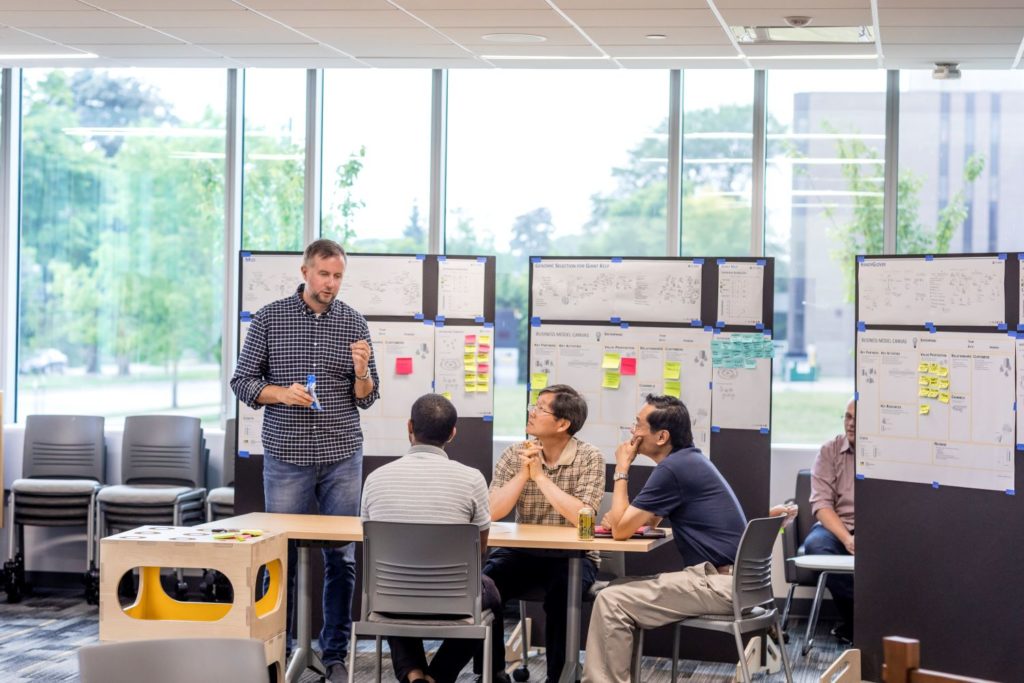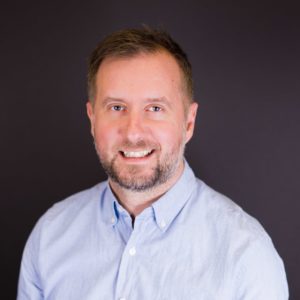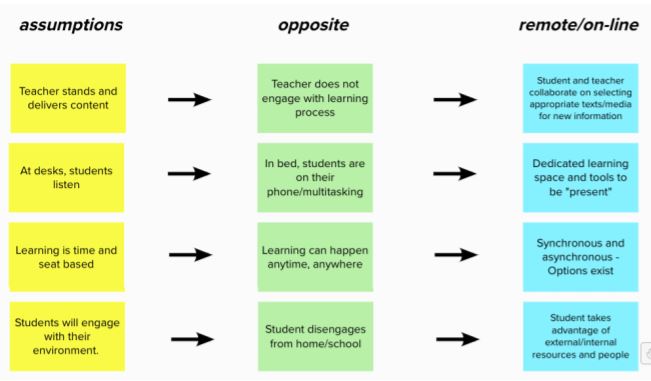
Dr. Ilya Avdeev, Director of Innovation at the UWM Lubar Entrepreneurship Center and Associate Professor of Mechanical Engineering at UWM published an article around thinking outside the box to reimagine medical education in the Medical College of Wisconsin’s (MCW) Transformation Times journal.
Read on below to read Dr. Avdeev’s article from the MCW Transformational Times, or read the pdf version here. Outside the Box.
 An Invitation to Reimagine Medical Education: Before Thinking Outside the Box, Think About the Box
An Invitation to Reimagine Medical Education: Before Thinking Outside the Box, Think About the Box
by Ilya Avdeev, PhD – Associate Professor of Mechanical Engineering at the
University of Wisconsin-Milwaukee
Transformation of something as established and complicated as medical education definitely qualities as a “wicked problem.” [1]. It is endlessly complex, with incomplete, contradictory, and changing requirements that make problem and solution identification very challenging. And yet we try. Like many of my colleagues in the MCW Kern Institute, I feel pressure to come up with bold “outside the box” ideas. The kinds of ideas that are leaps forward rather than small incremental improvements. Google calls these ideas “moonshots.” There are a number of tactics to enhancing the quantity and the quality of ideas. Here, we will assume that higher quality correlates with higher degree of transformation.
When it comes to the quantity of ideas, embracing problem constraints encourages the flow of creative ideas [2]. With students in design classes, we often use artificial constraints that are not even related to the project in order to help them to get “unstuck” during ideation. In academia, there are plenty of real constraints that you might want to embrace: limited budgets, approval of committees and gatekeepers, buy-in of faculty and students, etc.
Constraints are explicit. They are well-understood. They are important components of the proverbial box that we want to think outside of. Using constraints helps with the flow of ideas, but in and of itself might not lead to the bold thinking needed to reimagine medical education. A different tactic – questions assumptions – can be used to vastly expand the idea space, so the moonshot ideas get within reach. Let’s dive into it.
Method: Questioning Assumptions
Assumptions are often implicit and invisible. But when surfaced and challenged assumptions become launchpads for bold ideas. Let’s break it down into three steps. First, list all the assumptions you can think of about the problem you are trying to tackle. What are you taking for granted? Perhaps, invite someone from outside the team to ask questions that challenge the fundamentals. This is called “assumption storming” [3]. Second, “flip” listed assumptions to their opposites and write them down. You might want to take it a step further and imagine each assumption in a far future (2120?). Third, focus your attention on the flipped-assumptions column and generate solution ideas in a form of a “what if …?” question. Chances are, a bold idea will reveal itself in one of those questions. For example, if you were asked to reimagine a traditional three-ring circus, your assumptions and their opposites might look like this:
simultaneous acts > a single plot line
elephants > humans/actors
junk food > restaurant dinner
smell of animals > smell of perfume
loud circus music > classical music
a circus ring as a stage > a swimming pool as a stage
By looking at the opposites you might come up with these ideas for the reimagined circus:
“What if the circus act was performed by actors in a theater with a pool instead of a stage?”
“What if a dinner was served in circus instead of corn dogs?”
“What if the circus had one act with a classical music backdrop?”
Sounds crazy? Well, perhaps, that’s how the most innovative reinventing of a showbusiness genre was accomplished by Cirque du Soleil – a Montrealbased entertainment company and the largest contemporary circus producer in the world. Never heard of it? Check it out! [4].
Here is another example of using the tactic of questioning assumptions for expanding the solution space – a bit closer to reimagining medical education.
Questioning Assumptions: Reimagining Future of K-12 Education
“What if school became a community space for all ages based on knowledge, skill and desire to learn vs. an age-based assembly line?”
“What if mastery of content in a class drove learning and advancement vs. seat time?”
“What if we valued the process of learning just as much as the final outcome?”
These are just a few examples of questions that Milwaukee high-school teachers posed when we asked them to reimagine education in the near future, post-COVID. My UWM colleagues, Brian Thompson, Nathaniel Stern and Nicole Powley and I spent four days in early August with 32 high-school teachers re-imagining future of teaching and learning and designing experiments that could test their ideas and bring them to fruition.
The annual summer K-12 Design Thinking Bootcamp allows teachers to “try on” a Designer identity. This summer, we shifted our focus towards building-up teachers’ creative confidence in the face of ambiguous future. The foundation of our approach (learn design -> design learning) comes from the Teaching & Learning Studio Faculty Workshop at the Hasso Plattner Institute of Design at Stanford University (a.k.a. Stanford d.school) [5], our three-year project with Shorewood School District (three cohorts of teaching fellows, [6]) and Lubar Entrepreneurship Center human centered design workshops [7].
If crafted intentionally and thoughtfully “What If?” can unlock truly transformative ideas rather than practical incremental improvements. As compared to problem solving techniques which start with an enumeration of the “what is wrong?” or “ what needs to be fixed?” or even more appreciative inquiry approaches which begin by listing the strengths of the current state, the “What if?” approach is more likely to lead to a transformative set of ideas because it frames discussions around challenging the underlying assumptions of current practice rather than the practice itself.
Here is a set of future-looking provocations generated by teachers in this program:

Teachers came-up with these questions by listing all of the assumptions they have about high-school teaching and learning. After that, we asked them to “flip” those assumptions twice, first by thinking of opposites and then, by thinking of how these new questions or insights would impact their learning plans in the virtual environment.

Questioning Assumptions: Transforming Medical Education
So, how might we apply this simple technique to transformation of medical education? There are many challenges of modern health care that could be addressed by reexamining and transforming how we currently educate and train physicians. In the US, while we have a very expensive education and health care system this additional investment does not yield the outcomes we deserve as a population. This is in part due to limitations in training health care providers for the work they are expected to do and the maldistribution of physicians with respect to specialty choice and geographical practice.
Our physician diversity does not reflect the population which contributes to significant health disparities for underrepresented and underserved minority communities. Recent experience with the COVID-19 pandemic demonstrates that while our health care workforce responds to their duty to serve, our systems are not ready to ensure the safety of those professionals. So, we have many meaty problems to tackle.
It is unlikely that incremental innovations or tweaking the current predominant model of learning/teaching or delivering education simply by adding a new tech platform would get us far enough from the current state to address these challenges.
What if we used virtual learning and slow but inevitable extinction of large lectures and turn them into opportunities to think big? Students are no longer in-class with other peers, but they have access to anyone in the World remotely – why not consider how this might redefine the class boundaries? What if we reimagine the boundaries of the medical school? Do we need walls? Can students learn where they are? In the community? From the community?
Call for Action: It’s Your Turn
This is an open invitation for you to try generating new ideas using assumption storming technique. Use this simple on-line tool to try on your own: https://forms.gle/8fuv8Tyo12kcEHgk6
Question everything and dream big!
Acknowledgements
Thanks to Dr. Adina Kalet for her insightful feedback on this essay. Thanks to Brian Thompson, Nicole Powley and Dr. Nathaniel Stern for collaborating on K-12 Bootcamp and other projects at the UWM Lubar Entrepreneurship Center. Thanks to my TLS colleagues, Dr. Leticia Britos Cavagnaro, Erica Estrada-Liou, Dean Chang, Dr. Bre Przestrzelski, Meenu Singh and Timothy Moore, for their inspiration and for building the foundation of this work. Thanks to Dr. Kayt Havens, Dr. Karen Marcdante, Julia Schmitt and Dr. Chris Decker for their thought-partnership.
References:
1. Churchman, C. West (December 1967). “Wicked Problems”. Management Science. 14 (4): B-141–B-146
2. Onarheim, B., & Wiltschnig, S. (2010). Opening and Constraining: Constraints and Their Role in Creative Processes. In BT Christensen, T. Kristensen, & S. Boztepe (Eds.), Proceedings of the 1st DESIRE Network Conference on Creativity and Innovation in Design: DESIRE2010
3. http://www.assumptionstorming.com/
4. https://www.cirquedusoleil.com/o
5. https://dschool.stanford.edu/university-innovation/facultyworkshops
6. https://www.shorewood.k12.wi.us/apps/news/article/1011223
7. https://uwm.edu/lubar-entrepreneurship-center/pop-ups/
Ilya Avdeev, PhD is an Associate Professor of Mechanical Engineering at the University of Wisconsin-Milwaukee and an Adjunct Professor in the Kern Institute’s Human-Centered Design Innovator’s Lab
This article was shared from the Medical College of Wisconsin’s (MCW) Transformation Times journal.